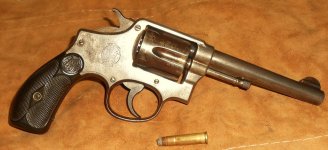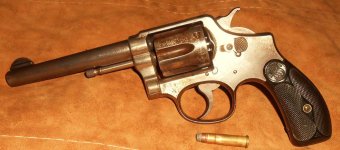Model 1899 or 1902?
I found this H-E in .32 Winchester (.32-20) today. I gave a bit more than usual ($150.00) but it was due to it's tightness, bore, and crown which I would describe as very good +.
Sadly the outside leaves more than a bit to be desired being nickled with most of it gone.
It's been years since I've run across a S&W .32-20 in any kind of sound mechanical condition and it will go well with my Rolling Block Sporter of the same caliber.
The last patent date is 1898, the serial is 5008 and it is matching on the frame, barrel, cylinder, and is also scribed on the right grip panel. The grips are in good shape, no cracks or chips.
One thing puzzles me and that was when I took the crane out of the revolver there was a spring-loaded pin present that engages a shallow hole in the frame. Was that supposed to be the cylinder lock before they went to the barrel lug lock?
I found this H-E in .32 Winchester (.32-20) today. I gave a bit more than usual ($150.00) but it was due to it's tightness, bore, and crown which I would describe as very good +.
Sadly the outside leaves more than a bit to be desired being nickled with most of it gone.
It's been years since I've run across a S&W .32-20 in any kind of sound mechanical condition and it will go well with my Rolling Block Sporter of the same caliber.
The last patent date is 1898, the serial is 5008 and it is matching on the frame, barrel, cylinder, and is also scribed on the right grip panel. The grips are in good shape, no cracks or chips.
One thing puzzles me and that was when I took the crane out of the revolver there was a spring-loaded pin present that engages a shallow hole in the frame. Was that supposed to be the cylinder lock before they went to the barrel lug lock?



